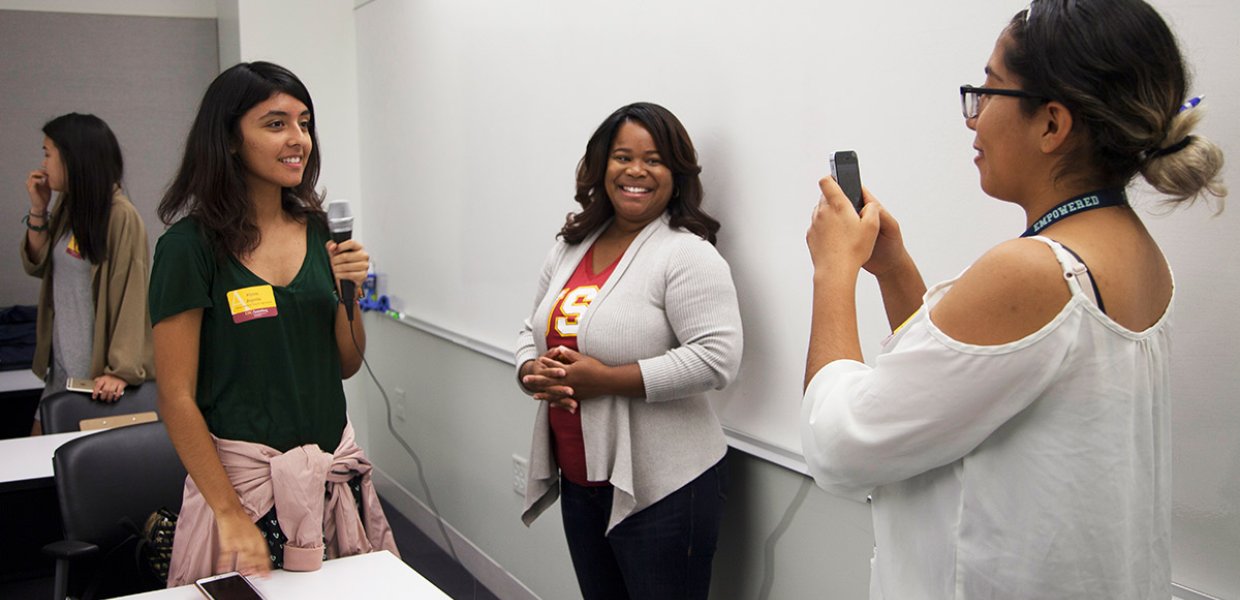When people think of the American civil rights movement, they don’t often consider Washington, Oregon and California as hotspots for Black activism. The Black Press, however, tells a different story. Black activists from the West Coast have crafted human rights campaigns that have often set the agenda for the rest of the nation — from the Gold Rush era all the way until today's Black Lives Matter movement.
To preserve Black media and amplify Black media makers, activists and social changemakers, Allissa Richardson has established the Charlotta Bass Journalism & Justice Lab at the USC Annenberg School for Communication and Journalism. It is the West Coast’s first Black media activism archive and social justice telling laboratory and will connect students to trusted media outlets that value Black storytelling.
Richardson, associate professor of journalism and communication and bestselling author of Bearing Witness While Black: African Americans, Smartphones and the New Social Justice #Journalism, serves as the Bass Lab’s inaugural director. We spoke with Richardson about her plans to build a clearinghouse that will aggregate Black social justice journalism.
What goals have you set for the new center?
In addition to recognizing Charlotta Bass, who is considered by many to be a hidden figure of the American civil rights movement, the goal of this lab is to preserve African American media history on the West Coast by bringing academic research to life and addressing educational gaps through studying and sharing Black activist media and the technologies that support it. Mrs. Bass’ work combined journalism and advocacy for marginalized groups and made an immense impact on the culture of the West Coast that we experience today. We want to honor her and others by focusing on building a robust archive of Black social justice journalism that people will be able to access online. The archive will contain primary source documents of curated citizen journalism during the uprisings of 2020 and beyond, and original oral history interviews in the form of what we're calling ‘virtual humans.’ Our mission is to make sure that America's history is not lost with those who lived it and once they are gone, their stories can live on.
Can you tell us more about virtual humans and other technology the Lab will engage with?
I am happy to announce that we're hard at work with USC’s Institute for Creative Technology to program the very first Black virtual human who will be able to share their iconic role in a modern movement for racial equality. We will use innovative technology that will record one-on-one interviews and transform the audio and visuals to create a virtual figure of the subject. This will allow guests to sit across from figures of the civil rights movement and prominent Black entertainers, athletes and social justice activists to have a conversation and really commune with them. We believe that capturing the stories of civil rights-era leaders is very urgent considering in just the last two years we've lost people such as John Lewis, Vernon Jordan, Cicely Tyson and SI Cordier.
We are also launching a mobile app this semester called Monumental AR. It will highlight both famous and little-known Black social justice monuments and landmarks on the West Coast. The augmented reality mobile app will allow people to go into various landmarks and iconic spaces to explore them in deeper ways. Users can see what used to exist and get answers to the history of that space, why it was so contentious, what was put in its place or why it was renamed.
In what ways will students be involved with the lab?
The Bass Lab exists for all students at USC. There are so many students that I encountered since 2020, who have asked me: ‘How can I help?’ ‘How can I become a better ally?’ ‘How can I tell better news stories?’ and ‘How can I be an anti-racist journalist?’. We will be bringing in curatorial fellows from USC Annenberg who will gain hands-on practical experience by assisting with creating media content and curating our archive. They will also conduct interviews, complete photogrammetry projects for our mobile application, record podcasts, and help amplify our message across digital and social media. Our fellowship offers $5,000 awards to several talented students each year and we're feeding the journalism pipeline by hosting a summer camp, which will teach south LA students the fundamentals of anti-racist reporting.
We also emphasize cross-cultural exchanges, especially since Charlotte Bass was a staunch ally of the early Mexican American civil rights movement and a strong supporter of the campaign to free Japanese Americans from internment camps during World War II. So, most immediately we're planning to host a regular lecture series to bring exciting African American media trailblazers to campus. One of our first big guests will be the Bass family, who is excited to come and visit and see our students in action.
What are your hopes for the Bass Lab’s future?
We would love to have a dedicated space where everyone can come and interact with our exhibits to learn more about the people whose stories we are telling. We envision our faculty fellows as collaborators who will help us fulfill our mission to save study and share the history of Black activism and social justice across news, media, politics and culture. During Black History Month we'll be unveiling our virtual human Voices of a Movement exhibit. And beyond all of this, we hope to make the Bass Lab at USC Annenberg a prime destination for anyone seeking to engage deeply with Black media and the activists, icons and journalists who’ve used that media to effect social change across time.
